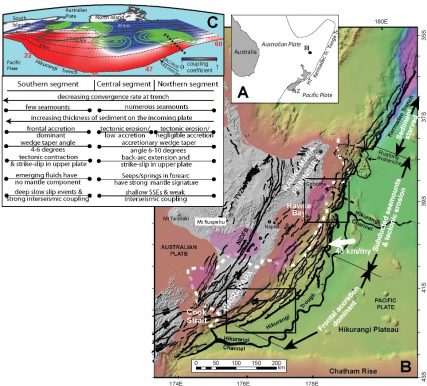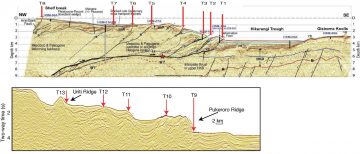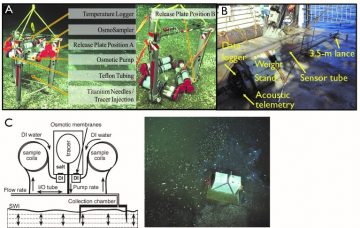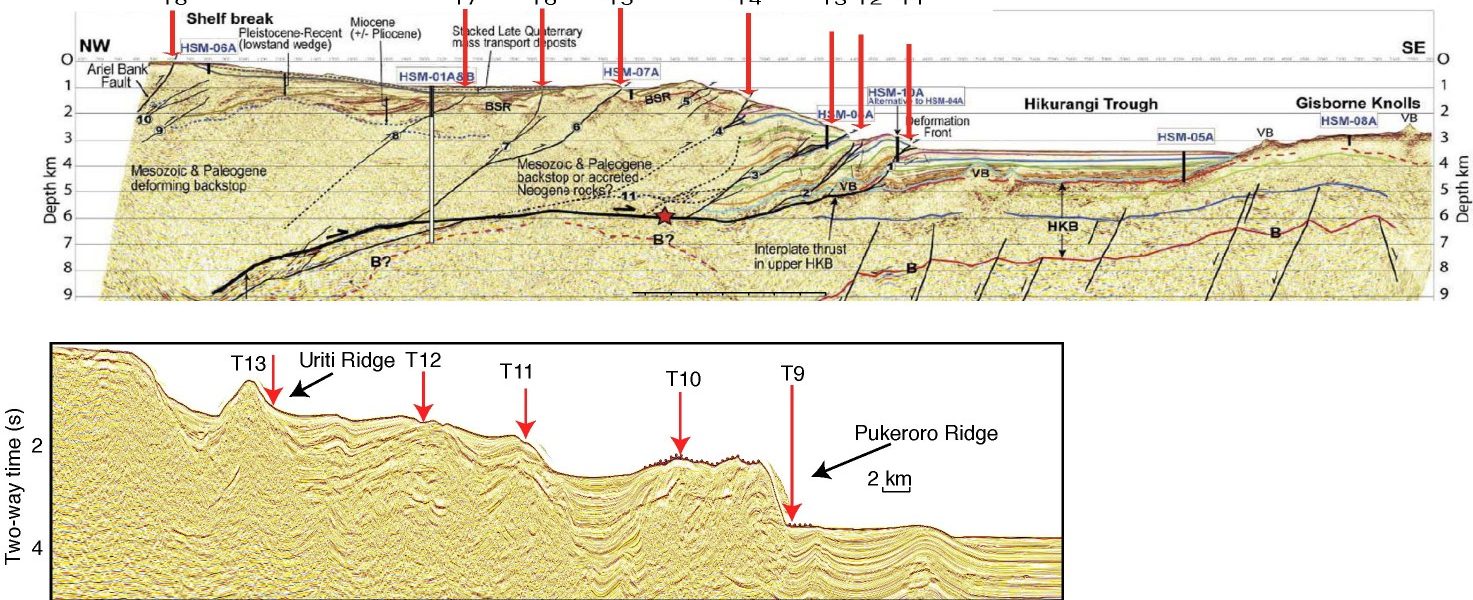Evan A. Solomon (University of Washington), Marta Torres (Oregon State University), and Robert Harris (Oregon State University)
Fluid generation, migration, and pore fluid pressure at subduction zones are hypothesized to exert a primary control on the generation of seismicity, low-frequency earthquakes, and slow slip events (SSEs) (e.g. Ranero et al., 2008; Obana and Kodaira, 2009; Saffer and Tobin, 2011; Saffer and Wallace, 2015). The SAFFRONZ (Slow-slip and fluid flow response offshore New Zealand) project addresses the GeoPRISMS Subduction Cycles and Deformation Initiative Science Plan by testing interrelationships among fluid production, fluid flow, and slow slip at the Hikurangi Margin. The recognition of dramatic changes in the along-strike distributions of SSEs and their recurrence intervals, interseismic coupling, inferred pore pressure, and other subduction-related parameters (Fig. 1) have resulted in a concerted international effort to acquire seismological, geodetic, other geophysical, and geomechanical data both onshore and offshore the Hikurangi margin. This effort includes recent scientific ocean drilling, logging, and the deployment of two subseafloor observatories during IODP Expeditions 372 and 375 (see page 16 of this issue), as well as a 3-D seismic reflection survey on the northern margin. (p. 14).
SAFFRONZ will complement and extend these efforts by providing:
A continuous two-year record of fluid flow rates and composition over the timeframe of the next expected SSE,
Information on the present background state and past locations of fluid flow and how they relate to inferred pore fluid overpressure along the plate boundary, and
Comparative geochemical and hydrologic data between the northern and southern sections of the margin.
The SAFFRONZ field program is scheduled for January 10 to February 14, 2019 on the R/V Revelle. Our field strategy employs a nested approach to constrain the margin-wide fluid flow distribution tied to estimated pore pressure evolution along the plate boundary from modeling studies and seismic attributes.
We are specifically targeting fault zones and off-fault locations between the deformation front and the shelf-break (Fig. 2). Site locations will be guided by pre-existing multi- and single-beam sonar data (including seafloor backscatter and water column indicators of gas seepage), 2D/3D seismic reflection data, and real-time water column multi-beam sonar surveys during the research expedition. Violin-bow heat flow measurements and piston coring will guide ROV Jason hydroacoustic surveys, Jason heat flow probe measurements, and the collection of push cores to further identify sites of active fluid discharge. Finally, the ROV surveys will guide the deployment of benthic fluid flow meters (Fig. 3) to generate a record of fluid flow rates and composition over a two-year period – the approximate recurrence interval for SSEs in this region. We anticipate deploying about sixteen benthic fluid flow meters, some co-located with seafloor bottom pressure recorders managed by GNS Science, during the 2019 field program.Although our focus is on the northern margin, the location of shallow SSEs and most research activity, we will also conduct ship and ROV operations and deploy a subset of fluid flow meters in the southern region of the margin.
Comparison of fluid flow pathways, fluid composition, fluid flow rates, and flow transients between the northern and southern areas will provide information on the differences in the nature of dewatering between the accretionary southern portion of the margin hosting deep SSEs and the dominantly non-accretionary northern portion with shallow SSEs. The along-strike comparison will also provide a control (reference) transect to compare regional (i.e. flow in response to SSEs in the north) to other hydrologic phenomena.
From both scientific and societal perspectives, results from this project will contribute to our understanding of fault slip behavior offshore New Zealand that have global implications for the postulated interdependence of temperature, pore pressure, fluid flow, and SSEs at subduction zones. The ability to integrate the SAFFRONZ experiment with concurrent bottom pressure recorder deployments, onshore cGPS data, IODP borehole monitoring experiments, 2D and 3D seismic reflection data, and other data to be collected along the margin in the next few years greatly enhance the outcomes of this project. The synthesis of the results from all the concurrent experiments being conducted at Hikurangi promises to be very exciting and the integration of the hydrologic data produced from this project will result in an unprecedented view of deformation and hydrological responses to slow slip at subduction zones. ■




